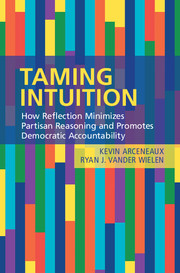Book contents
- Frontmatter
- Contents
- List of Figures
- List of Tables
- Preface and Acknowledgments
- 1 Democratic Accountability and the “Rational” Citizen
- 2 A Theory of Individual Differences in Reflection and the Intuitionist Model of Political Reasoning
- 3 Measuring Individual Differences in Reflection
- 4 Toeing the Line: Partisan Identities and Policy Attitudes
- 5 Throwing the Rascals Out: Partisan Identities and Political Evaluations
- 6 Can't We Disagree without Being Disagreeable? The Role of Reflection in a Polarized Polity
- 7 Reflections on the Role of Reflection in Democracies
- Appendix Details of Empirical Studies and Statistical Analyses\
- Notes
- References
- Index
4 - Toeing the Line: Partisan Identities and Policy Attitudes
Published online by Cambridge University Press: 30 August 2017
- Frontmatter
- Contents
- List of Figures
- List of Tables
- Preface and Acknowledgments
- 1 Democratic Accountability and the “Rational” Citizen
- 2 A Theory of Individual Differences in Reflection and the Intuitionist Model of Political Reasoning
- 3 Measuring Individual Differences in Reflection
- 4 Toeing the Line: Partisan Identities and Policy Attitudes
- 5 Throwing the Rascals Out: Partisan Identities and Political Evaluations
- 6 Can't We Disagree without Being Disagreeable? The Role of Reflection in a Polarized Polity
- 7 Reflections on the Role of Reflection in Democracies
- Appendix Details of Empirical Studies and Statistical Analyses\
- Notes
- References
- Index
Summary
For the remainder of the book, our goal is to assess the effects of reflection on political reasoning and its implications for democratic accountability. Before embarking on this endeavor, it is important that we reiterate the textbook model of democratic accountability we introduced in Chapter 1. At its base lies a simple notion. The public holds elected officials accountable by reelecting incumbent office holders who perform in ways that conform with the public's preferences and by voting for candidates challenging incumbents when their actions do not conform with the public's preferences. Put simply, democratic accountability is about throwing the rascals out when they do a poor job. If the public is incapable of throwing the rascals out, there is nothing stopping incumbent officeholders from following their own personal preferences and interests at the expense of the public's (Ferejohn, 1986).
To briefly summarize the problem presented in Chapter 1, people's partisan identities may make it difficult for them to identify who the rascals are. The textbook model of democratic accountability is built on a few micro-foundations that concern the behavior of individuals in the polity. First, the model assumes that people possess coherent preferences that are logically connected to an ideological system, or political worldview, that encapsulates guiding principles for what government should do (Lenz, 2012). Second, the model assumes that people are capable of evaluating incumbent politicians on the basis of their preferences and in light of the facts about elected officials’ performance in office (Ferejohn, 1986). In this chapter we focus on the first assumption, and we visit the second assumption in Chapter 5.
What does it mean for people to possess coherent preferences? In this context, we do not use the term “preferences” in its colloquial sense as a tendency to want something. Rather, we use it as a technical term that lies at the center of rational choice models. A preference is a clear rank ordering of what people want and do not want, and that rank order must be logically consistent. In order for people to have preferences over flavors of ice cream, to take a silly example, they must be able to rank flavors from most liked to least liked, and that preference ordering must follow the dictates of logic, such as the law of transitivity (Chong, 2013).
- Type
- Chapter
- Information
- Taming IntuitionHow Reflection Minimizes Partisan Reasoning and Promotes Democratic Accountability, pp. 88 - 112Publisher: Cambridge University PressPrint publication year: 2017



